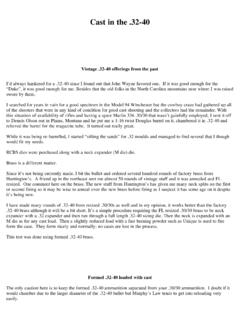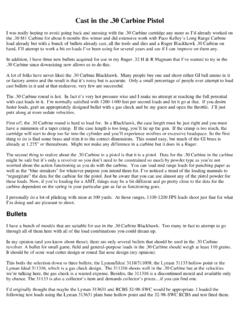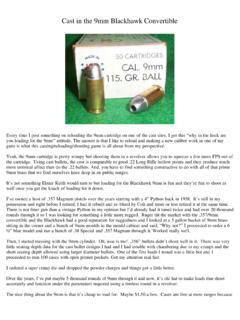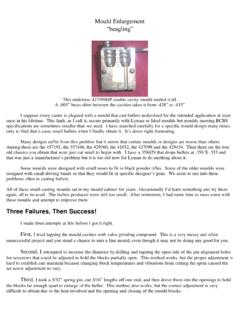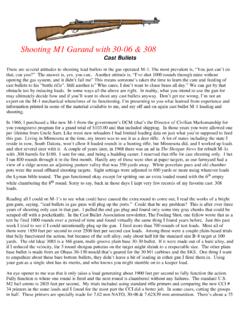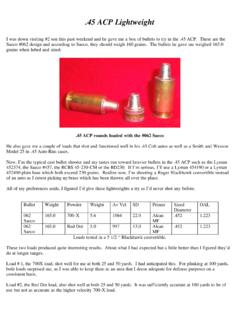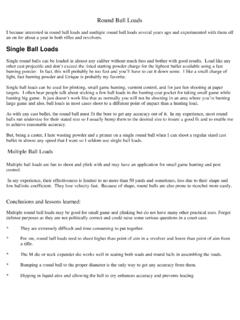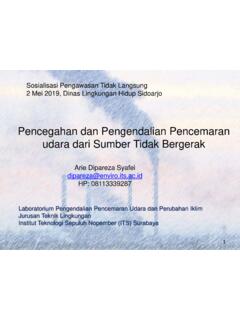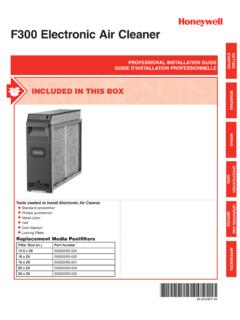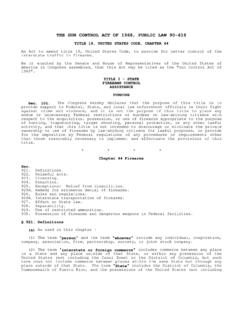Transcription of CAST BULLET LOADS FOR MILITARY R - Castpics
1 CAST BULLET LOADS FOR MILITARY RIFLES Cast bullets can make shooting that surplus rifle easy and economical. And basic data works for many different guns. BY C. E. HarrisCast BULLET LOADS usually give a more useful zero at practical field ranges with MILITARY battle sights than do full powerloads. Nothing is more frustrating than a MILITARY rifle that shoots a foot high at 100 yards with surplus ammo when thesight is as low as it will go! Do not use inert fillers (Dacron or kapok) to take up excess empty space in the case. Thiswas once common practice, but it raises chamber pressure and under certain conditions contributes to chamber a particular load will not work well without a filler, the powder is not suitable for those conditions of loading. Fourload classifications from Mattern (1932) cover all uses for the cast BULLET MILITARY rifle.
2 I worked up equivalent chargesto obtain the desired velocity ranges with modern powders, which provide a sound basis for loading cast bullets in anypost-1898 MILITARY rifle from 7mm to 8mm: 1. 125 grain plain based "small game/gallery" 900-1000 , 5 grains of Bullseye or equivalent. 2. 150 grain plain based "100-yard target/small game", 1050-1250 , 7 grains of Bullseye or equivalent. 3. 170-180 grain gas checked "200 yard target", 1500-1600 , 16 grains of Hercules #2400 or equivalent. 4. 180-200 grain gas-checked "deer/600 yard target", 1750-1850 , 26 grains of RL-7 or equivalent. None of these LOADS are maximum when used in full-sized rifle cases such as the 30-40 Krag, .303 British, , Jap, Russian , or 30-06. They can be used as basic load data in most modern MILITARY rifles of7mm or larger, with a standard weight cast BULLET for the caliber, such as 140-170 grains in the 7x57, 150-180 grains inthe.
3 30 calibers, and 150-190 grains in the 8mm. For bores smaller than 7mm, consult published data. The Small Game or Gallery" Load The 110-115 grain bullets intended for the .30 carbine and .32-20 Winchester, such as the Lyman #3118, #311008,#311359, or #311316 are not as accurate as heavier ones like the #311291. There isn't a readily available .30 calibercast small game BULLET of the proper 125-130 grain weight. LBT makes a 130 grain flat-nosed gas-check BULLET for H&R Magnum which is ideal for this purpose. I recommend it highly, particularly if you own a .32 revolver. The "100 Yard Target and Small Game" Load I use Mattern's plain-based "100 yard target load" to use up my minor visual defect culls for offhand and rapid-fire100 yard practice. I substitute my usual gas-checked bullets, but without the gas-check.
4 I started doing this in 1963with the Lyman #311291. Today I use the Lee .312-155-2R, or the similar tumble-lubed design Mostof my rifle shooting is done with these two basic designs. Bullets I intend for plain based LOADS are blunted using a flat-nosed top punch in my lubricator, providing a 1/8" flatwhich makes them more effective on small game and clearly distinguishes them from my heavier gas-checked makes more sense to me than casting different bullets. BULLET preparation is easy. I visually inspect each run of bullets and throw those with gross defects into the scrap boxfor remelting. Bullets with minor visual defects are tumble-lubed in Lee Liquid Alox without sizing, and are used forplain base plinkers. Bullets which are visually perfect are weighed and sorted into groups of +/- grain for use in200 yard matches.
5 Gas checks are pressed onto BULLET bases by hand prior to running into the lubricator-sizer. For gas-check bullets loaded without the gas- checks, for cases like the .303 British, NATO, Russian and 30-06,I use 6-7 grains of almost any fast burning powder. These include, but are not limited to Bullseye, WW231, SR-7625,Green Dot, Red Dot or 700-X. I have also had fine results with 8 to 9 grains of medium rate burning pistol or shotgunpowders, such as Unique, PB, Herco, or SR-4756 in any case of .303 British or larger. In the case, use no more than 4 grains of the fast burning powders mentioned or 5 grains of the shotgunpowders. Theses make accurate 50 yard small game LOADS which let you operate the action manually and save yourprecious cases. These plinkers are more accurate than you can hold.
6 Repeated loading of rimless cases with very mild LOADS results in the primer blast shoving the shoulder back, unlessflash holes are enlarged with a No. 39 drill bit to " diameter. Cases which are so modified must never be usedwith full powered LOADS ! Always identify cases which are so modified by filing a deep groove across the rim andlabeling them clearly to prevent their inadvertent use. For this reason on I prefer to do my plain based practice shootingin rimmed cases like the 30-30, 30-40 Krag, 303 British and which maintain positive headspace on the rimand are not subject to this limitation. The Harris "Subsonic Target" Compromise Mattern liked a velocity of around 1250 for his 100 yard target load because this was common with the leadbullet .32-40 target rifles of his era. I have found grouping is best with non gas- checked bullets in MILITARY rifles atlower velocities approaching match grade.
7 22 long rifle ammunition. I use my "Subsonic Target" load at around 1050-1100 to replace both Mattern's "small game" and "100 yard target" LOADS , though I have lumped it with the lattersince it really serves the same purpose. It's report is only a modest "pop" rather than a "crack". If elongated BULLET holes and enlarged groups indicate marginal BULLET stability, increase the charge no more than a fullgrain from the minimum recommended, if needed to get consistent accuracy. If this doesn't work, try a BULLET which ismore blunt and short for its weight because it will be more easily stabilized. If this doesn't do the trick, you mustchange to a gas-checked BULLET and a heavier load. The Workhorse Load - Mattern's "200 yard Target" My favorite load is the most accurate. Mattern's so-called "200 yard target load.
8 " I expect 10 shot groups at 200 yards,firing prone rapid with sling to average 4-5". I shoot high Sharpshooter, low Expert scores across the course with anissue 03A3 or M1917, shooting in a cloth coat, using may cast BULLET LOADS . The power of this load approximates the32-40, inadequate for deer by today's standards. Mattern's "200 yard target load" is easy to assemble. Because it is amild load, soft scrap alloys usually give better accuracy than harder ones, such as linotype. Local MILITARY collector-shooters have standardized on 16 grains of #2400 as the "universal" prescription. It gives around 1500 with a150-180 grain cast BULLET in almost any MILITARY caliber. We use 16 grains of #2400 as our reference standard, just ashigh power competitors use 168 Sierra Match Kings and 4895. The only common MILITARY rifle cartridge in which 16 grains of #2400 provides a maximum load, and which must notbe exceeded, is in the tiny case.
9 Most SKS rifles will function reliably with charges of #2400 as light as 14grains with the Lee 312-155-2R at around 1500 I designed this BULLET especially for the , but it worksvery well as a light BULLET in any .30 or .303 caliber rifle. Sixteen Grains of #2400 is the Universal Load The same 16 grain charge of #2400 is universal for all calibers as a starting load. It is mild and accurate in any largermilitary case from a 30-40 Krag or .303 British up through a 30-06 or , with standard weight bullets of suitablediameter for the caliber. This is my recommendation for anybody trying cast bullets LOADS for the first time in amilitary rifle without prior load development. I say this because #2400 is not "position sensitive", requires no fiberfillers to ensure uniform ignition, and actually groups better when you stripper-clip load the rifle and bang them off,rather than tipping the muzzle up to position the powder charge.
10 Similar ballistics can be obtained with other powders in any case from to 30-06 size. If you don't haveHercules #2400, you can freely substitute 17 grains of IMR or H4227, 18 grains of 4198, 21 grains of Reloder 7, 24grains of IMR 3031, or grains of 4895 for comparable results. However, these other powders may give some vertical stringing in cases larger than the unless the charge ispositioned against the primer by tipping the muzzle up before firing. Hercules #2400 does not require this 't ask me why. Hercules #2400 usually gives tight clusters only within a narrow range of charge weights within agrain or so, and the "universal" 16 grain load is almost always the best. Believe me, we have spent a lot of time tryingto improve on this, and you can take our word for it. The beauty of the "200 yard target load" at about 1500 is that it can be assembled from bullets cast from thecheapest, inexpensive scrap alloy, and fired all day without having to clean the bore.
